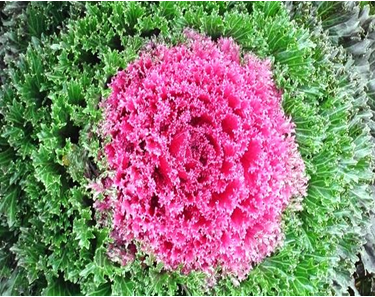by Ken Lain, the mountain gardener

Few Flowers are more elegant in Fall than Watters select varieties of ornamental kale. The subdued fall tones are perfect for containers, beds, and borders. And it’s so easy to grow! These unique Prescott Selections are an award-winner for cold hardiness, intense red, purple, white, and pink coloring in a frilly package. Matures to 1′ foot tall and wide.
Textures vary from smooth ruffled rosettes to intensely curled heads. Generally, the cabbage cultivars have soft scalloped leaves and stay lower to the ground. In comparison, kale varieties are feathery, sometimes taller, that hold their color better. Like edible cabbages and kales, ornamental varieties slow down or almost stop growing above ground generally in December. If planted in time, most types hold at 12-18″ tall and wide right through winter.
With the onset of warm weather, the fragrant gold flowers rise 2′ feet above the foliage. They thrive in cold weather and the perfect accent with pansies, dusty miller, conifers, evergreen grasses, and perennials. Many taller varieties are popular in floral shops for bouquets and arrangements.
Leaves and flowers of ornamental cabbages and kales are edible! Restaurants use the attractive leaves as a garnish that is also tasty in a salad, stir-fry, and kale chips.
In Spring, the fragrant flowers are an early source of pollen for migrating hummingbirds and butterflies.
Facts: Ornamentals
Family: Brassicaceae
Genus: Brassica oleracea Acephala Group= kale (no head), Capitata Group= cabbage (heads)
Common Name: Ornamental cabbage and kale
Origin: Western Europe
Culture: Cool weather biennials that intensify in color with temperatures close to freezing. They require 4+ hours of sun, consistent moist, with soil that drains. These plants persist through winter in the Prescott area and bolt (elongate and go to flower) when temperatures warm in early Spring.
Once the plants bloom, they begin to deteriorate\. Some gardeners love the flowers while others do not. Removing flower stalks as they elongate prolongs the ornamental life. Cabbage and kales can be buried by snow and the coldest of winter nights.
Maintenance: Since ornamental cabbages and kales grow best in colder weather, they require very little care. Water at least once per week, even on cold winter nights, for a continual winter show.
Pests and Diseases: Watch for aphids in late fall and early spring. Aphids are easily controlled with Triple Action and Multi-Purpose Insect Spray.
Propagation: Ornamental cabbages and kales are generally propagated by seed sown in July.
Varieties you will find at Watters Garden Center:
Osaka Pink
Rich purple outer leaves with pink inner leaves. Large smooth leaves have gently undulating edges that create a dense texture.
Osaka Red
Same as Osaka Pink but has rich magenta inner leaves.
Coral Prince
Dark green and white leaves with pink centers. Some of the white-tipped leaves even have green dots around the edges. Deeply incised leaves give plants a lacy effect.
Coral Queen
Ornamental kale with showy purple leaves and a magenta center. Deeply incised leaves give plants a lacy effect.
Crane or Pigeon Kale
This tall variety is used in floral arrangements. They grow tall stems topped by a foliage rosette in a variety of colors.
Glamour Red
This award-winning variety has a unique fringed leaf. Center leaves are bright magenta surrounded by green with outer leaves a pale purple. Mature size is 12″ tall and wide.
Purple Peacock
This variety is most reminiscent of its edible cultivars: finely dissected purple leaves and bright magenta centers. Leaves are loosely arranged on 18″ tall x 18″ wide.
White Kamome
The extremely tight head of green leaves caresses a white inner core. Individual leaves have heavily ruffled edges.
White Peacock
Similar to Purple peacock, but has green leaves with white veins and white speckled center leaves.

